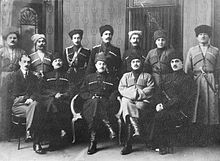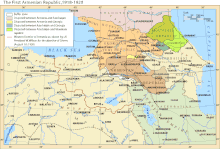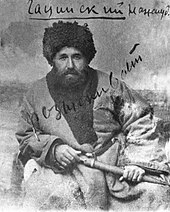Mountain republic

The North Caucasian Mountain Republic ( Russian Горская республика , completely Russian Союз объединённых горцев Северного Кавказа и Дагестана ; in German-language literature usual translation: Union of Mountain Peoples of the North Caucasus and Dagestan , sometimes called (Autonomous) Mountain Peoples Union called) was a result of the disintegration of the Russian Empire in the February Revolution and the October Revolution of 1917, initially autonomous , later independent state in the North Caucasus with Dagestan , which existed until 1918/19 and 1920 respectively. The mountain republic was not a very stable state structure and in the course of the Russian civil war was repeatedly involved in fierce battles against local groups of the Bolsheviks , who were under the command of Sergo Ordzhonikidze in the Caucasus . Some politicians of the Union also joined the Bolsheviks, who promised the national minorities extensive autonomy. The republic was finally crushed in December 1918 / January 1919 by the white volunteer army under General Denikin . Sometimes it is confused with the Republic of Ter-Dagestan , with which it was allied, although its government was under Nadschmuddin Gozinski in Temir-Chan-Shura and which, after the break-up, saw itself as the successor to the Mountain Republic and sometimes called it that. Some politicians sat equally in the government of the mountain republic and in the government of the Republic of Ter-Dagestan, which, however, only claimed the areas of the Terek Oblast , the Dagestan Oblast and some more northern areas for itself. In fact, it existed until the Red Army captured it in January – March 1920.
government
The Central Committee, the 15-17-strong Presidium appointed by him and the government also appointed by the Central Committee sat in Vladikavkaz and, after its loss, briefly in Nazran . The 30-strong Central Committee consisted of the chairmen of the national councils elected after the February Revolution of 1917 of the numerous peoples of the North Caucasus and Dagestan (the larger ones are the Chechens , Avars , Circassians , Lesgians , Dargins , Ossetians , Kumyks , Karachay and Ingush , as well as smaller peoples) . As a result of the social structure of these peoples at that time, the members of the Central Committee and the government were mostly princes, tribal leaders, Sufi sheikhs and Islamic clergy, as well as some entrepreneurs, intellectuals and engineers. Prime Minister was the Chechen ex-officer and wealthy Grozny Tapa oil entrepreneur Chermoev . Other well-known personalities were Foreign Minister Haidar Bammatow, a lawyer, the Kabardian (East Cherkess) Prince Pschemacho Kozew, Prime Minister in the last months from December 1918, the Kumyk Prince Nuch-Bek Tarkowski, Prince Sultan-Kaplan Girej, a descendant of the ruling dynasty of the Crimean Khan , the great-grandson of the long-time leader of the uprising against Russia Imam Shamil , Muhammad Said-bey Shamil, the Ossetian-Christian intellectual Nikolai Dschiojew, or the two Islamic clergy and Sufi sheikhs Nadschmuddin Gozinski (Nadsch ad-Din from Hozob) and Ali Hadschi Akuschinski (Ali Hadschi from Akusha , he later allied with the Bolsheviks).
There was also a clergy from the North Caucasus composed of Islamic clergymen, including Gozinski. Until January 1919, however, the mountain republic viewed itself as over-religious, in which Muslim, Christian and Jewish residents could also participate.
history
In May 1917, the mountain republic was proclaimed as the Autonomous Union of the Mountain Peoples at the 2nd Congress of the Mountain Peoples of the North Caucasus in Maikop . All national councils of the peoples of the North Caucasus, the Abkhazians , the southern Ossetians in Georgia , the Nogai , the Kalmyks , the Turkmen minority in the Stavropol region and the Rada of the Cuban Cossacks , whose territories were all claimed, took part. Short term, the Mountain Republic united in January 1918 at the instigation of the three Cossacks - Atamans the Don Cossacks (Ataman Kaledin ), Terek Cossacks (Ataman Karaulov) and the Kuban Cossacks (Ataman Filomonow) for "Southeast Federation of Cossacks, mountain and steppe peoples" with the capital Yekaterinodar , In the next month, however, it disintegrated again into the mountain republic and the autonomous states of the Kuban, Terek and Don Cossacks. In the course of the fighting against the Bolsheviks, the leadership of the mountain republic fled from Vladikavkaz to the Georgian capital Tbilisi in March 1918 , but the mountain republic was re-established in Vladikavkaz on May 11, 1918 with Ottoman and German help. The mountain republic received support and official recognition from the German Empire , the Ottoman Empire and the other central powers of the First World War , and later also from the Democratic Republic of Georgia and the Democratic Republic of Azerbaijan . The mountain republic was also on friendly terms with the autonomous people 's republic of the Kuban Cossacks. However, diplomatic tensions arose with Azerbaijan because the mountain republic claimed the range of Northeast Caucasian languages in North Azerbaijan, while Azerbaijan claimed the city of Derbent and its surroundings in Dagestan, where mainly Azerbaijani is spoken. After protracted fighting against the Bolsheviks, the mountain republic was finally destroyed by a campaign by the White Army between October 1918 and December 1918 and January 1919. On December 15, 1918, it declared its independence, but soon afterwards the leading politicians fled into exile in Baku , Tbilisi, Batumi or Temir-Chan-Shura.
successor
As mentioned, the Republic of Ter-Dagestan regarded itself as the successor to the mountain republic, but only claimed north-east and central-north Caucasian areas for itself, but in fact only dominated the north-east Caucasian mountains and the surrounding area (something of today's Dagestan, Chechnya and Ingushetia ) in alliance with the Mountain republic. On December 1, 1917, it stood as the autonomous "Temporary Ter-Dagestani Government" ( Russian: Временное Терско-Дагестанское правительство ) and proclaimed its allied Mountain Republic under Prime Minister Nadschmuddinig-Gozief-Mai in 19 May Independence from Russia. After the mountain republic was smashed, she saw herself as her successor, and some politicians from the mountain republic joined her. However, large parts of their territory were conquered by Denikin by May 1919, with the exception of a few mountain areas into which the government had fled. Thereupon Gozinski left the government and in memory of Imam Shamil proclaimed the Imamate Caucasus and himself as the “ Imam of the Caucasus”. His friend Usun Hadschi Saltinski proclaimed the “Emirate of the Caucasus” in Chechnya and declared himself the “Emir of the Caucasus”. The government of the Ter-Dagestani Republic gradually dissolved and was finally crushed with the invasion of the Red Army. In September 1919, the mountain people of Dagestan and Chechnya succeeded in driving Denikin's troops out of the mountains in an uprising led by Gozinski with Usun Hajis participating. In contrast to the former mountain republic, Ter-Dagestan, Imamat and Emirate had a more Islamic character since January 1919. Since that time, Sharia courts have been established as before under Imam Shamil . Finally, in January – March 1920, Northeast Caucasus was conquered by the Red Army under Sergo Ordzhonikidze. Gozinski resisted the Soviet Union in the mountains until 1925, Usun Hajji until 1929 . The Autonomous Soviet Republics ASSR Dagestan and ASSR of the Mountain Peoples (the latter later divided into several republics) were territorially heirs of the Mountain Republic and the Ter-Dagestan Republic. Like the Abkhazia SSR (1921–31), later the Abkhazia ASSR , the Autonomous Oblast of South Ossetia and the Kalmykia ASSR, they were a concession to the aspirations for independence and autonomy of the peoples in the Greater Caucasus and the surrounding area, partly in alliance with the Bolsheviks.
The Confederation of the Caucasus Peoples, based in Sukhumi , was also formed in 1991 with the gradual collapse of the Soviet Union in memory of the Union of the Mountain Peoples. It was also an association of oppositional national parties of the peoples of the North Caucasus with Dagestan and also the Abkhazians and South Ossetians. Initially opposed to Russia, it lost due to numerous disputes between the peoples (cf.e.g. between Laken and Chechens, between Kumyks and mountain peoples, between the peoples in Kabardino-Balkaria and Karachay-Cherkessia , separation of Ingushetia from Chechnya, etc.) up to a short war in 1992 between Ossetians and Ingush (see article Ingushetia ) their credibility. It still exists today, but has little political influence.
The name of the terrorist underground organization Caucasus Emirate under Doku Umarow is linked to the name of the Caucasus emirate of Usun Hajji. However, in contrast to Usun Haji 's emirate , its supporters consist largely of anti- Sufist Islamists .
literature
- Wolfdieter Bihl : The Caucasus Policy of the Central Powers , Part 2 The time of the attempted Caucasian statehood (1917–1918) . Böhlau, Vienna 1992, pp. 277-279. ISBN 3-205-05517-9
- Karl Grobe-Hagel : Russia's “Third World”. Nationalism and nationality conflicts and the end of the Soviet Union. Frankfurt am Main 1992. pp. 142-143. ISBN 3-88332-183-4
- Тимур М. Музаев: Союз горцев. Русская революция и народы Северного Кавказа, 1917 – март 1918 г. (German: Timur M. Musajew: Die Bergvölkerunion. The Russian Revolution and the Peoples of the North Caucasus, 1917 – March 1918. ) Patrija, Moscow 2007. ISBN 978-5-902940-02-9
- Werner Zürrer: Caucasus 1918–1921. The struggle of the great powers for a land bridge between the Black and Caspian Seas . Droste, Düsseldorf 1978. pp. 28-41, pp. 220-229, pp. 306-341. ISBN 3-7700-0515-5
Web links
Article about the mountain republic from the Dagestani history magazine Achulgo on the page gazavat.ru (Russian).
Individual evidence
- ↑ The basis of this map is obviously this map of the mountain republic by the Caucasus historian Artur Zuzijew from the "Atlas of the Ethno-Political History of the Caucasus" published in 2006 in Russian in Vladikavkas, which was also published in English in 2014 by Yale University Press . . In Zuziyev's light green regions are labeled with “Of which areas with predominantly Christian population” - Abkhazia , North Ossetia and the areas of the Sunscha - Cossacks - while the dark green regions are predominantly Muslim.
- ↑ For structure and personalities cf. Bihl p. 278/79
- ↑ Akuschinski was later the first “People's Commissar for Canonical Islamic Law” in the ASSR Dagestan; Emanuel Sarkisyanz : History of the Oriental Peoples of Russia until 1917 Munich 196, p. 140. Gozinski and Usun Hadschi also initially had contacts with Bolsheviks against the White Army .
- ↑ Zürrer p. 41.
- ↑ Bihl p. 277
- ^ Article on the mountain republic in the Russian history magazine Chronos (Russian) 2nd and 3rd paragraph.
- ↑ Zürrer p. 222.
- ↑ Bihl p. 279.
- ↑ Zürrer p. 306 ff.
- ↑ Bihl p. 278
- ↑ Zürrer p. 310/11
- ^ Article on the mountain republic in the Russian history magazine Chronos (Russian) 3rd paragraph, last sentence.
- ↑ Dittmar Schorkowitz: Post-communism and decreed nationalism Frankfurt am Main 2008, p. 139.
- ↑ See e.g. B. Uwe Halbach : From Mansur to Dudayev? Resistance traditions of the North Caucasian mountain peoples. In: Uwe Halbach (Ed.): Caucasus hot spot. Baden-Baden 1995, p. 196-215, especially p. 197.





